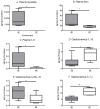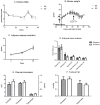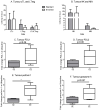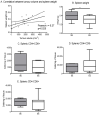Spontaneous Physical Activity in Obese Condition Favours Antitumour Immunity Leading to Decreased Tumour Growth in a Syngeneic Mouse Model of Carcinogenesis
- PMID: 35008220
- PMCID: PMC8750291
- DOI: 10.3390/cancers14010059
Spontaneous Physical Activity in Obese Condition Favours Antitumour Immunity Leading to Decreased Tumour Growth in a Syngeneic Mouse Model of Carcinogenesis
Abstract
Our goal was to evaluate the effect of spontaneous physical activity on tumour immunity during aging. Elderly (n = 10/group, 33 weeks) ovariectomized C57BL/6J mice fed a hyperlipidic diet were housed in standard (SE) or enriched (EE) environments. After 4 weeks, orthotopic implantation of syngeneic mammary cancer EO771 cells was performed to explore the immune phenotyping in the immune organs and the tumours, as well as the cytokines in the tumour and the plasma. EE lowered circulating myostatin, IL-6 and slowed down tumour growth. Spleen and inguinal lymph node weights reduced in relation to SE. Within the tumours, EE induced a lower content of lymphoid cells with a decrease in Th2, Treg and MDCS; and, conversely, a greater quantity of Tc and TAMs. While no change in tumour NKs cells occurred, granzyme A and B expression increased as did that of perforin 1. Spontaneous physical activity in obese conditions slowed tumour growth by decreasing low-grade inflammation, modulating immune recruitment and efficacy within the tumour.
Keywords: immunosenescence; lymphocytes T helper; mammary carcinogenesis; obesity; perforin 1; physical activity; sedentary lifestyle.
Conflict of interest statement
None of the authors has any conflict of interest to report. The authors are responsible for the content and writing of the paper.
Figures









Similar articles
-
Long-Term High-Fat Diet Limits the Protective Effect of Spontaneous Physical Activity on Mammary Carcinogenesis.Int J Mol Sci. 2024 Jun 5;25(11):6221. doi: 10.3390/ijms25116221. Int J Mol Sci. 2024. PMID: 38892407 Free PMC article.
-
Modulation of inter-organ signalling in obese mice by spontaneous physical activity during mammary cancer development.Sci Rep. 2020 May 29;10(1):8794. doi: 10.1038/s41598-020-65131-9. Sci Rep. 2020. PMID: 32472095 Free PMC article.
-
Vitamin D supplementation associated with physical exercise promotes a tolerogenic immune environment without effect on mammary tumour growth in C57BL/6 mice.Eur J Nutr. 2021 Aug;60(5):2521-2535. doi: 10.1007/s00394-020-02420-z. Epub 2020 Nov 10. Eur J Nutr. 2021. PMID: 33169226
-
Metabolic control of tumour progression and antitumour immunity.Curr Opin Oncol. 2014 Jan;26(1):92-9. doi: 10.1097/CCO.0000000000000035. Curr Opin Oncol. 2014. PMID: 24305570 Free PMC article. Review.
-
Immuno-oncology: understanding the function and dysfunction of the immune system in cancer.Ann Oncol. 2012 Sep;23 Suppl 8(Suppl 8):viii6-9. doi: 10.1093/annonc/mds256. Ann Oncol. 2012. PMID: 22918931 Free PMC article. Review.
Cited by
-
Long-Term High-Fat Diet Limits the Protective Effect of Spontaneous Physical Activity on Mammary Carcinogenesis.Int J Mol Sci. 2024 Jun 5;25(11):6221. doi: 10.3390/ijms25116221. Int J Mol Sci. 2024. PMID: 38892407 Free PMC article.
-
Comparison of Lean, Obese, and Weight-Loss Models Reveals TREM2 Deficiency Attenuates Breast Cancer Growth Uniquely in Lean Mice and Alters Clonal T-cell Populations.Cancer Res. 2025 Apr 3;85(7):1219-1235. doi: 10.1158/0008-5472.CAN-24-3511. Cancer Res. 2025. PMID: 39841585
References
Grants and funding
LinkOut - more resources
Full Text Sources
Research Materials

